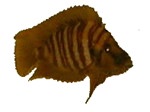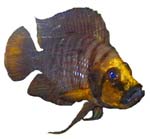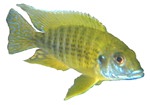
| Altolamprologus -
Tanganyika. Smaller races (A. compressiceps "Dwarf, Shell"
) can be kept as small as a 10 gallon tank, the rest (A.
calvus "Black", A. compressiceps , etc...) are in the
20+ tank range. In all types, the females are about 1/2 to
1/3 the size of the males. Shells are an essential decoration
in tanks housing these fish, as the females often take refuge
deep inside them where the males are too large to reach. These
fish feed on invertebrates, although there have been many
reports that they will also consume small fish, such as Cichlid
fry. These fish are very aggressive towards each other, although
they tend to leave other tankmates alone. They usually form
pairs and spawn in the shells, although they may practice
polygamy if an excess of females is present in the tank. |

Altolamprologus compressiceps
"Mwele Bright Orange"
|

Altolamprologus compressiceps
"Gold Head"
|

Altolamprologus compressiceps
"Gold Face"
|

Altolamprologus calvus "White"
|
|

Altolamprologus calvus "Black"
|
Aristochromis - This Malawian genus only houses one species, Aristochromis christyi. It grows to a fairly large size, and is primarily predatory. It should be kept in at least a 75 gallon tank. They are polygamous mouthbrooders.
|
Aulonocara - Peacocks. Native to Lake Malawi. These Cichlids feed primarily on invertebrates found in the sand. They are polygamous mouthbrooders, best kept in groups or 1m/2f trios. For an African Cichlid they are very peaceful. The smaller species (A. steveni, A. sp. "Flavescens", A. stuartgranti, A. lwanda, etc...)can be kept in tanks as small as a 20 gallon, as a trio, the larger ones (A. ethelwynnae, A. jacobfrebiergi, A. mbenji, A. hansbaenshci...)are not recommended for anything less than a 30, although something closer to a 55 is recommended. Only males develop color. |

Aulonocara maulana
"Bicolor" |

Aulonocara roberti
"Blue Gold" |

Aulonocara sp.
"Albino Eureka" |

Aulonocara sp.
"Maleri Red" |

Aulonocara carolae
"Swallowtail" |

Aulonocara sp."Eureka" |

Aulonocara ethelwynnae |

Aulonocara mamelela
"Lemon Jake" |

Aulonocara sp.
"Lwanda Red Top" |

Aulonocara jacobfriebergi |

Aulonocara sp."Blue Neon" |

Aulonocara hansbaenschi
"Red Shoulder" |

Aulonocara kandeensis
"Blue Orchid" |

Aulonocara hansbaenschi
"Regal" (Dwarf, aka. mozambique) |

Aulonocara baenschi
"Sunshine / Benga" |

Aulonocara maisoni "Chitimba"
(aka. "Yellow Long Pelvic") |

Aulonocara sp. "German Red" |

Aulonocara stuartgranti "Ngara Flametail" |
| Benthochromis - B. tricoti is currently the only recognized species, native to Lake Tanganyika. These are larger fish considered "Featherfins", although also similar to the sardine Cichlids. This fish feeds on crustaceans. This is an extremely difficult fish to ship, which looses its extensions when captured from the deep. Females are rarer as they are harder to catch, and captive bred individuals are almost never available, as Benthochromis are difficult to spawn. A tank larger than 100 gallons in recommended. |

Benthochromis tricoti |
| Buccochromis - These are extremely large predatory fish from Lake Malawi. They must be kept in tanks of at least 100 gallons, although 125+ would be more preferable. They are not very aggressive, but are active. They are polygamous mouthbrooders. (Formerly Haplochromis) |

Buccochromis leptura |
| Callochromis - are native to Lake Tanganyika. These fish are smaller versions of the Featherfins (Ophthalmotilapia & Cyanthopharynx). As micro-predatory sand sifters, be sure to use a substrate such as crushed coral sand. Most Callochromis are smaller fish, the smallest species such as C. pleurospilus can reportedly be spawned in a species aquarium as small as 20 gallons. Callochromis, polygamous mouthbrooders, are moderately peaceful fish. |

Callochromis macrops
"Red" (young male) |
| Chalinochromis - hails from Lake Tanganyika. Similar to Julidochromis. They are a micro predator, and monogamous substrate spawners. 20 gallons + is usually adequate. They are pretty peaceful. |

Chalinochromis brichardi |
|